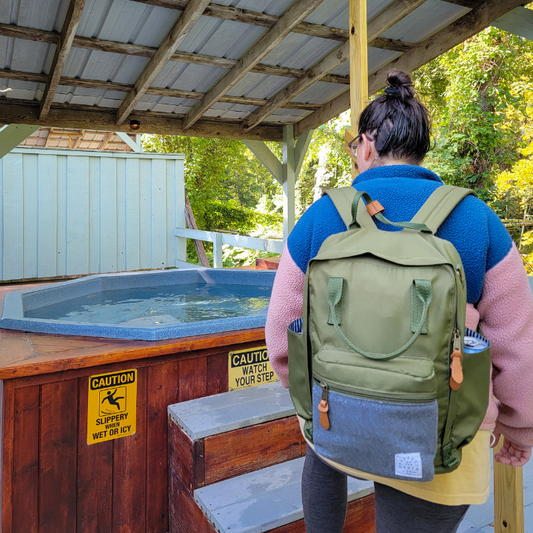As with anything new, there is a lot to learn when it comes to first-time parenting. From choosing what diapers to use, deciding on feeding preferences, finding a healthy sleep cycle for both you and baby to knowing exactly what keeps your baby safe, cared for, and thriving while asleep, leaves a lot for a new parent to juggle.
Although we aren’t ones to provide direct advice on how to raise your child, we are here to help guide you through the small and large nuances that come with this new season of life.
We wholeheartedly believe that every parent knows what’s best for their child and family. However, we also recognize that not everything works for everyone, but swaddling a child may be one of those things that make everyone in a crowd roar in agreement with a resounding “yes” to try with your infant.
This guide will be similar to our posts about “How To Baby-Proof A House” and “How To Change A Diaper When Traveling.” As a diaper bag backpack and sustainable baby gear company, a lot of our customers here at Product of the North are first-time parents. We want to provide them with not only high-quality products but also information and advice to help them on their parenting journey.
Let’s dive into understanding swaddling in more detail.

What is Swaddling?
In simplest terms, swaddling is a way to gently and securely wrap your baby in a breathable, lightweight blanket.
The goal of swaddling is to help your baby feel safe and secure, especially during sleep, like when they were in the womb.
Comforting our children is an essential part of their physical and emotional development. It is also a great way to help them fall into a restful sleep, especially in their infancy.
Swaddling is a technique that has been around for millions of years and used across a variety of cultures with one goal in mind; to mimic the security your child felt in the womb while they sleep.
Swaddling has various benefits, but getting the technique down pat can feel like a struggle, especially if you’re a first-timer.
Trust us when we say that there is a slight learning curve when it comes to swaddling, but with our tried and tested steps, you’ll be a swaddling pro in no time, and your baby will probably fall asleep faster and stay asleep for longer.

What Kind of Swaddle Should You Use?
As with baby clothes and other accessories, swaddle type is based mostly on your preference. It is important to choose blankets that are specifically designed for swaddling.
Generally speaking, there are two main types of swaddles:
- A traditional swaddle is a large, thin blanket that is soft, stretchy, and large enough to wrap around your baby.
- A two-in-one swaddle is a more complex baby wrap that helps with swaddling your child without needing a tuck or intricate wrap design. They often come with snaps, buttons, or zipper closures and allow your baby to be swaddled with hands in or out of the blanket.
No matter what type you think would work best for your child, we encourage you to choose ones that are comfortable, breathable, and made from eco-friendly materials such as organic cotton.
You may quickly realize that you will need to try both types to see what your child prefers. Some babies struggle with swaddling, while others get the hang of it almost instantly. If your baby is crankier when swaddled, consider trying a different type of blanket or swaddle to determine if it makes a difference for them.

What are the Benefits of Swaddling?
Swaddling has various benefits for infants and babies.
Some of our favorite reasons to consider swaddling include:
- Mimicking the feeling of being in the womb
- Mimicking the feeling of being held in a parent’s arms
- Body temperature regulation
- Helping reduce the symptoms of colic
- Reducing the Moro reflex that causes them to startle quickly
- Reducing SIDS incidents
- Creating a more regulated sleep routine and a happier, well-rested child.

How To Swaddle A Baby Step-By-Step
We know that swaddling can be intimidating. As with changing diapers or bottle feeding, swaddling a baby will become second nature with practice. The main thing to remember when it comes to swaddling is safety. Following our step-by-step instructions will help alleviate any errors and allow you to wrap up your baby safely and securely.
Step 1: Find a Flat Surface
Lay your swaddle blanket in a diamond shape on a flat surface such as your bed, the baby’s crib, changing table, or on a cushioned area on the floor. Fold the top corner of the blanket down about six inches. This is where your child’s head will go.
Step 2: Place Your Baby Face-Up on the Blanket
Place your baby on the blanket face up. Their head should land above the folded portion of the blanket, with their body extending straight down to the bottom point of the diamond shape.
Step 3: Straighten Your Baby’s Left Arm
With your baby’s arms by their side, take the left side of the blanket and lay it over their left arm and chest. Tuck the blanket under their right arm and back. After this step is completed, your baby’s left arm and chest should be covered with their right arm still exposed.
Step 4: Cover Their Right Side and Bring Up the Bottom
Take the bottom corner of the blanket and fold it up over your baby’s body. Tuck it under the first fold directly under their chin. Next, take the right corner of the blanket and fold it over your baby’s right arm and chest, tucking it under their left side so that it lays under the left side of their back.
Step 5: Secure the Swaddle Blanket
Lastly, take the remaining bottom of the blanket and fold or twist it underneath the body portion of their body.
If your baby prefers their arms free, it is okay to leave out one or both arms as necessary.
If you’ve purchased a swaddle two-in-one wrap, please follow the precise instructions provided with the item to ensure proper swaddling.
Is Swaddling Safe?
As with most things, there is a level of risk associated with swaddling. But, in short, swaddling is safe and effective if done correctly.
The American Academy of Pediatrics (AAP) says that swaddling can encourage your newborn to sleep better as long as it’s done correctly and in accordance with other safe sleep guidelines.
Some important things to consider when swaddling your baby include:
- Temperature – is the room temperature at a sufficient level to support a comfortable climate for your baby when swaddled. It should not be too hot as it could lead to overheating.
- Material – Consider using thin and breathable material such as organic cotton, and never place additional blankets or coverings over a swaddled baby.
- Positioning – Don’t ever place the blanket above your baby’s shoulders, as this could lead to suffocation.
- Hip placement – Make sure your baby can move their hips and knees freely to avoid the risk of dislocation or dysplasia.
- Sleep position – Always place your baby to sleep on its back.
-
Age – Swaddling should only last until your baby begins to roll over, typically around 3-4 months.
Swaddling Safety Tips
Safety is key when it comes to swaddling, especially for new parents. In addition to the above guidelines, it is important to follow our top safety tips when swaddling your baby:
- Always put your baby to sleep on their back.
- Swaddle snugly but not too tight. You should be able to fit two to three fingers between your baby’s chest and the swaddle. If not, it’s too tight.
- Keep baby cool [If swaddling makes your baby too warm, it can raise the risk of sudden infant death syndrome (SIDS)]
- Swaddle for both night sleeps and nap time.
- Stop swaddling when your baby begins to roll over (usually around 3-4 months). Once a baby is more active, it increases their risk of breaking free from a swaddle which could lead to blanket accidents such as suffocation.

Wrapping Up Our Step-By-Step Guide on How To Swaddle A Baby
Swaddling is a great way to encourage comfortable and restful sleep that mimics the womb experience for your baby, especially during the first three to four months of life. Although swaddling is not a parenting requirement, it is a tried and true technique that helps your baby sleep better, reduce their Moro reflex, and reduce the risk of SIDS.
No matter what you decide, we believe that a happy, safe sleep environment is key to adjusting to the new (sometimes non-existent) sleep cycle that is newborn parenting. Your baby’s safety is our top priority through all stages of parenthood.
As a first time parent, there are so many things to learn and remember. Swaddling may seem like one of the more trivial tasks, but it can make a big difference in your baby’s comfort and sleep habits. Hopefully, this guide has helped you feel confident in wrapping your little one up nice and snug.
If you have any questions or concerns about swaddling, be sure to consult with your pediatrician – they will be able to give you personalized advice based on your baby’s specific needs. And finally, don’t forget to stock up on all the supplies you need for nursing before your baby arrives – we recommend checking out our sustainable diaper bag backpacks and other family-friendly travel gear!



